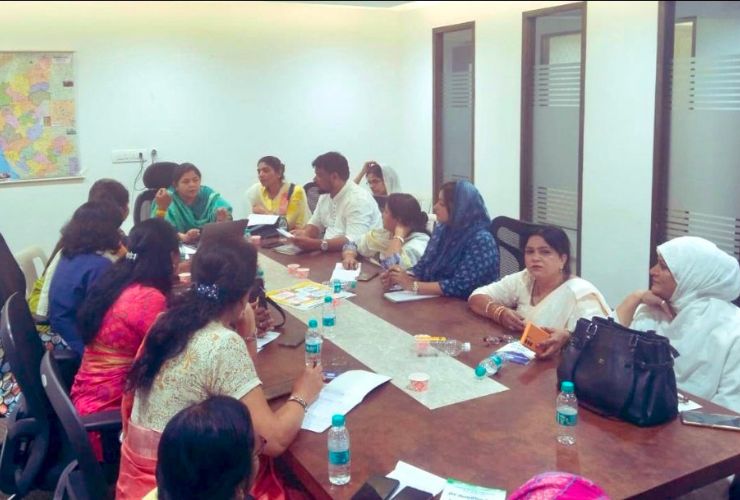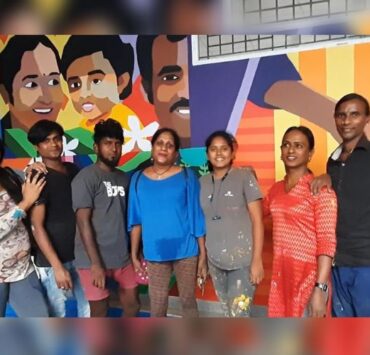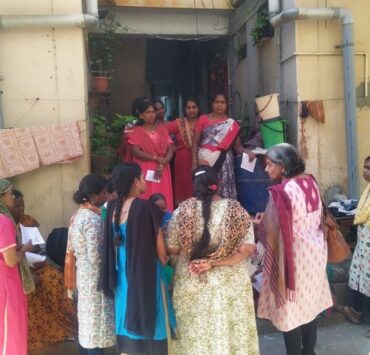
By C.G. Manjula

Over five thousand (5,102) nominations were filed by 3,632 candidates for the Karnataka Assembly polls to be held on May 10. Of the total number of nominations, 4,710 were filed by 3,327 male candidates and 391 by 304 female candidates; there was only one nomination in the ‘other gender’ category. According to officials attached to the Chief Electoral Office, Karnataka, a single candidate could file up to four nominations until the last date for candidates to withdraw from the fray: 24 April.
The final number of candidates left in the electoral fray after the deadline for withdrawal is 2,613. Among them are 2,427 male candidates, 185 female candidates and one candidate from the ‘other gender’ category. Women make up 7.6 per cent of the total number. Once again this reflects the ground reality of the negligible participation of women as candidates in the electoral democratic process in the state.
During the last Assembly Elections in Karnataka, in 2018, out of the total of 2,626 candidates across 222 constituencies, only 209 were women, making up slightly less than 8 per cent. Only seven of them won the elections – a mere three per cent.
This is despite the fact that Karnataka has been hailed as the first state to introduce reservation for women in elected bodies by reserving 25 of seats for women in the Panchayat Raj system in the early 1980s, when Ramakrishna Hegde was the Chief Minister and Abdul Nazir Saab was the Rural Development Minister. The state’s pioneering initiative preceded by almost a decade the 73rd Amendment to the Constitution, which mandated decentralised, local governance, with one third of seats reserved for women, across the country.
It is important to note that the state government initiated this policy on its own, without any external pressure from women’s organisations or anyone else. However, despite this and its traditional image as a progressive and developed state, Karnataka has not had a single female Chief Minister or even Deputy Chief Minister to date.
Kamaladevi Chattopadhyay was the first woman in India to run for political office. She competed for a seat in the Madras Legislative Assembly and lost by a mere 55 votes. Even though she was defeated, it is significant that she had contested elections as far back as the 1920s. With the Women’s Indian Association calling for women’s representation in legislatures, Dr Muthulakshmi Reddy was nominated to the Madras Legislative Council in 1926 and became the first Indian woman to become a legislator. There is, therefore, no shortage of inspiring pioneers and role models for women’s political leadership in the country. The leadership model provided by Kamaladevi Chattopadhyay, who hailed from Mangaluru in Karnataka, continues to be memorable.
What happened to these legacies? The politics of representation is essential to democracy. However, the political representation of women remains skewed to this day. Although election fever is currently high in the state, the voices of women are barely heard. Unfortunately, at this point, the number of women legislators in Karnataka is lower than it was in the 1950s and ‘60s. Political parties have not been showing any concern about the situation and continue to ignore women while deciding on who will be given tickets to contest elections.
It is clear that the root cause for this is the persistent social and cultural prejudices against women. Even though India is celebrating its 75th year of Independence, the fight against faulty, discriminatory social institutions continues. One sign of this is the lopsided ratio of women in the political sphere.
Since the state’s first Legislative Assembly came into being in 1952, there have been just about 30 or 31 female ministers. Most of them have handled the departments of Women and Child Development or Kannada and Culture. This underlines the concept that women are primarily family caregivers and upholders of culture.
The government of SM Krishna, then with the Congress Party, had the maximum number of women in the cabinet of ministers in 1999. The portfolios handled by these women were as follows: Motamma – Department of Women and Child Development, Rani Satish – Department of Kannada and Culture, Suma Vasanth – Department of Muzrai, Nafees Fazal – Department of Medical Education and later Department of Science and Technology.
No government since then has ever had four women ministers at the same time. However, during the Bharatiya Janata Party (BJP) led government in 2008, Shobha Karandlaje also broke the portfolio stereotype by handling the Rural Development and Panchayat Raj, Food and Civil Supplies as well as Power portfolios.
Grace Tucker was the first woman to get a cabinet post in Karnataka, serving as Deputy Minister of Education in the Congress government of S Nijalingappa in 1957. Leelavati (Venkatesh) Magadi of the Indian National Congress (INC) was the Deputy Minister in charge of Khadi Gramodyog, Handloom and Small Industries in 1958 in the Congress government led by Chief Minister BD Jatti. Yashodhara Dasappa was the Minister for Social Welfare in 1962 in the Congress government led by Chief Minister SR Kanthi.
In the 1970s KS Nagarathnamma was the first woman to become Speaker of the Karnataka Legislative Assembly. In 1979 Sumati Madiman, who was elected as Deputy Speaker of the Assembly, worked efficiently; in 1980, a few months before she passed away, she was elected to the post of Assembly Speaker, too. MR Lakshmamma, Rani Satish and Vimala Gowda worked successfully as Deputy Chairpersons of the Karnataka Legislative Council; Basavarajeshwari Jahagirdar was the first woman Chairperson of the Council. Film actor and MLC Jayamala, the lone woman cabinet minister in the HD Kumaraswamy government in 2018, had been leader of the House in the Legislative Council. Motamma, a Dalit politician who held several important positions in the Congress party, was nominated as the leader of the opposition in the Legislative Council in 2010; she was the first woman to hold that post.
Bengaluru, which began to be known as the centre of Information Technology and the Silicon Valley of India from the 1990s onwards, has 28 constituencies. In 2008 Shobha Karandlaje won the election from the Yeshwanthpur constituency. However, since then, over the last 15 years, no woman has won elections from this constituency. In contrast, 66 years ago, in 1957, three female candidates had won elections from various constituencies in Bengaluru: Grace Tucker, Nagarathnamma and Lakshmi Ramanna (all three from the Congress Party) were elected from Ulsoor, Gandhinagar and Chamarajapete respectively. Pramila Nesargi won from Chamarajpete twice – first on a Janata Party ticket in 1978 and then on a BJP ticket in 1994. Sowmya Reddy of the Congress won from the Jayanagar constituency during the 2018 state elections. However, it is a matter of concern that only six women have been elected as MLAs from different constituencies of Bengaluru over the past 66 years.
Srirangapatna, in Mandya district, has been considered a traditionally safe constituency for women to win. After the 1986 by-election, for about two decades women MLAs from the Congress and Janata Dal parties represented this constituency. Despite this history, no female candidate was fielded in Srirangapatna during the last state election in 2018. This time, too, there are no female candidates here.
Political calculations take into account caste and religious communities while selecting candidates to contest elections. Although women constitute more than 49 per cent of the population of the state, female voters do not seem to be considered as a separate category of voters. In recent times women have been gaining some importance in political calculations since the proportion of women exercising their franchise as voters have been increasing. According to Election Commission (EC) data, during the last Assembly elections, the number of women voters had increased by 16 per cent. The EC had established 450 “Sakhi” polling booths to encourage women to vote.
In recent election campaigns, political parties have been trying to woo women voters in a big way. During the last state elections, Prime Minister Narendra Modi used the slogan ‘Beta Beti Ek Saman’ (son, daughter equal) in his campaign speeches. However, the BJP fielded only six female candidates during the 2018 Assembly elections – not even 3 per cent of the total number of candidates fielded by the party. Three of the six women won the elections.
Rahul Gandhi, who was then president of the Congress Party, had said at an event in Bengaluru a few days before the 2018 assembly elections in Karnataka, that he wanted to see at least 10 women Chief Ministers from the Congress across the country in the next 10 years. “I know that my statement will annoy many men here, mainly senior leaders, but that is the agenda I am going to set,” he said, adding that he was not satisfied with the number of women to whom the Karnataka unit had given tickets. The Congress had fielded 15 women candidates and six of them had won.
The Janata Dal (Secular) party or JDS insists that it has given its full support to the Women’s Reservation Bill, which sought to reserve one-third of seats for women in the Lok Sabha and state Legislative Assemblies and was first introduced in Parliament in 1996, when JDS Chief HD Deve Gowda was Prime Minister. The party has a woman farm labourer carrying a stack of paddy on her head as its party symbol. Deve Gowda had said during a JDS women’s rally in 2017 that if the Women’s Reservation Bill becomes law, Karnataka would get 84 women MLAs. He had written a letter to Prime Minister in 2017 to take action to pass the long-pending Bill and again urged him last week to ensure that it becomes law.
It was reported that Deve Gowda had suggested to his son and current JDS supremo, HD Kumaraswamy, to identify women candidates to be fielded in 2018. However, JDS ultimately fielded only four female candidates during the last Assembly elections and none of them won.
On the last day of the 15th State Legislative Assembly (24 February 2023) BJP leader BS Yediyurappa said more women should be elected and called on men to make it possible. However, most women know that such statements are just tactics to woo women voters. They know how difficult it is to get tickets without the support, financial strength or lobbying skills of male relatives.
All the three major parties in the state – BJP, Congress and JDS – have fielded no more than 13 women each for the upcoming election. The number of women who have been given tickets to contest in the election remains abysmally low across parties. Each party has given barely 5 per cent of their total tickets to female candidates. While the JDS has fielded 13 women ahead of the May 10 elections, the BJP has fielded 12 women and the Congress has fielded 11 women this time.
There are only 38 female candidates out of the 389 final nominations in Bangalore, with no women standing for election in several of the city’s constituencies. A report in The New Indian Express sought to analyse patriarchal attitudes towards women candidates.
It is a Constitutional commitment to provide equal opportunities for women. Article 14 of the Constitution recognises the right to equality as a fundamental right. Article 15 (3) enables and empowers the State to make special provisions for the benefit of women and children. Article 39a says that the state should create opportunities to ensure equal justice for those deprived of justice due to financial and other reasons.
India is a signatory to the Convention on the Elimination of All Forms of Discrimination against Women (CEDAW), which dates back to 1979. Under Article 7 of CEDAW, the state should take suitable measures to eliminate all discrimination in political and public life. This Article asserts that women should also be equally eligible to participate in elections. It asserts that women also have equal rights to participate in the formulation of government policies and their implementation.
Despite all this, there have been no genuine efforts from the political class in India to share power with women. Inequality in political representation appears to be taken as normal. This is at least one reason why India, as a nation, is lagging behind with regard to gender equality. The country was ranked 132 out of 191 countries in UNDP’s Human Development Index (HDI) in 2021-22. It was ranked 122 on the Gender Inequality Index (GII) in the same report; share of seats in Parliament in terms of the percentage held by women is among the indicators used for the GII. India has fallen several places in the Inter-Parliamentary Union’s global ranking of women’s parliamentary presence from 117 after the 2014 general election to 142 as of March 2023.
Of late there has been much talk and celebration of India as the “Mother of Democracy”. Is it possible to think of the nation as the most populous, if not greatest, democratic country in the world when half of its population – female citizens – is barely represented in Parliament and state Legislative Assemblies?




